
Bobby and Kelli McDaniel are building their ranch and herd
Three years ago, Bobby and Kelli McDaniel purchased a 560-acre farm because it was close to the Robson Ranch, where Bobby works as a foreman.
Frank Robson owns four stocker ranches with four full-time ranch hands and three day-workers used when working the cattle, spraying, haying and other labor-intensive activities. Bobby’s job consists of managing employee numbers and performance, as well as the logistics of buying and selling cattle, organizing haying, purchasing grain and other duties.
Bobby’s grandfather Theron managed Watt Henry Ranch in Adair, Okla., while his father John also worked there later, taking over as the manager when Theron retired.
Bobby learned to ride as soon as he could walk. One of his clearest early memories was riding to get where the cattle were being worked and watching the fire branding. Bobby attended college and then earned a master’s degree in agricultural nutrition from Oklahoma State University, where he began his professional career taking care of the research facility.
Kelli also came from a farming background. Her parents Linda and Johnny were full-time educators who also ran a small farm with 30 to 40 head of cattle.
Kelli was also influenced by her parents’ educational careers, with a mother working as special education teacher and a father as a middle school principal. Taking after her parents, Kelli became a special education teacher and is now employed at Vinita High School as a resource teacher. She sees mostly special education students enrolled in regular classes and helps with social goals and emotional growth as well as tutoring.
“It’s a rewarding career as I try to steer my students in a better direction when they’re having difficulties of any kind, Kelli explained.
Because the McDaniel ranch is in its beginning stages, many of its practices are still in development. An example is that Bobby is still not retaining heifers for replacements because that need has not yet arisen. The ranch supports 93 Angus/Gelbvieh cross cows and six Balancer bulls.
“The market prefers black cattle and the Angus/Gelbvieh cross adds better milking ability to the Angus and produces a great calf,” Bobby explained.
This year Bobby bought two new bulls, which he believes will suffice for the next two years as long as they don’t get too big. He considers milkability and calving ease when looking at the EPDs, but learned from his father and grandfather that “what you see with your eye is what you get.” Bobby, therefore, analyzes the confirmation of a perspective bull and prefers a sloping shoulder, a straight and flat back and straight hind legs for breeding ease.
At this point, Bobby is not interested in running a registered herd because his position at the Robson operation takes up a great deal of time. Consequently, his own operation is streamlined for efficiency. An example is selling calves right off the cows at 7 to 8 months, with the steers averaging 656 pounds and the heifers 625 pounds. The calves most often are sold at the nearby South Coffeyville Stockyards because Bobby believes in personal relationships and they have taken excellent care of him for years.
“Mr. Robson taught me not to put all my eggs in one basket,” Bobby said. “Selling calves twice a year means if the prices are lower at one sale time, I hopefully can make up the difference at the next.”
Both groups of cattle are worked in the spring and in the fall. Bobby believes one of the most important improvements in the cattle industry is in pharmaceuticals with a strong and carefully followed vaccination program being essential. Watching the stockers at the Robson operation Bobby found those calves who are not vaccinated often don’t do well.
“Some don’t think about the other guy in the cattle industry, but selling poorly conditioned calves raises rancher outputs and consumer prices,” Bobby said. “What often happens at Robson’s is unvaccinated calves need more than a booster and may never reach target weight goals.”
Nutrition is the other obvious health component. Bobby raises his own hay with some hay ground having prairie grasses, such as big and little bluestem, switchgrass and Indian grass. He also has fescue and Bermuda hay fields. The growing seasons of the grasses fit together in a pattern that allows for maximum nutritional value at different times of the year. Additional nutrition comes from 14-percent protein, corn-based cubes that are sometimes fed to the cattle all winter depending upon forage availability.
While Bobby is just starting his ranch, he looks to the future. He thinks the industry may someday change with calves going straight to the feedlot as a more efficient production method. Further, Bobby is planning on raising replacement stock relatively soon and perhaps eventually entering the breeding stock market.
“No one learns the cattle industry in a vacuum,” Bobby said. “I’ve learned much from many people but my father and grandfather as well as Oklahoma State University professors Gerald Horn, Bob Wettemann and Bob Cropp stand out as teaching me the most. Always learning and to keeping up with new advances in the industry is essential in retaining profitability.”






